
Hi Gang…
Back in the late ‘50s and early ‘60s, a series of books was released by “Sports Car Press” of New York. There were wonderful titles in this collection covering such varied topics as:
- Sports Cars of the World, by Halmi
- Races That Shook The World, by Walkerley
- Your Sports Car Engine, by Ludvigsen
- Porsche Guide, by Sloniger
- Women in Sports Car Competition, by Mull
There were many other titles too, that were creative, insightful, fun, and incredibly interesting. Finding a complete run of these books today is no small feat, and I’m still in the process of building my library with this powerful pack of books by noted authors and participants of the day. And one of the authors of a very special book in this series was writer, designer, and Art Center automotive styling and design instructor, Strother MacMinn.
Strother “Mac” MacMinn….. His Book….. His Car….
As I’ve researched “Mac’s” history, I’ve come across two statements time and time again. First, people lament that he never designed a car that fully reached the light of day. And two, he never wrote a book on automotive styling. The book we are reviewing today breaks both myths, as follows:
- First, it’s a book authored by Mac with many of his own illustrations
- Two, the car shown on the cover of the book is none other than the LeMans Coupe – a car that DID see the light of day by at least two different design and build teams in the late ‘50s and early ‘60s.
I like breaking myths!
Today we’ll focus on just the portion of the book having to do with his short biography as well as the futuristic car he helped design – the LeMans Coupe. Let’s start with Mac’s biography.
Strother MacMinn: Overview of Book and Biography
Here’s what is shown just inside the cover of Mac’s book introducing the topic and the author.
This book discusses many previously produced sports car prototypes that have in one way or another affected the development and progress of sports car design. Each one is a significant experiment or advanced example.
It includes sports dream cars produced by both American and European manufacturers as well as some coachbuilders’ prototypes such as: GM SS and SR Corvette series, La Salle II, Oldsmobile F-88, Chrysler Gran Turismo-type dream cars, Bertone B.A.T. series, Abarth 750 cc record breakers with Bertone and Farina bodies, Alfa Romeo Flying Saucer series, Mercedes-Benz SLR series, etc.
There is also a general summary of mechanical components which seem most likely to appear in future standard sports car design. A small section is devoted to hypothetical body designs based on possible component arrangement and general chassis development that would seem likely to occur in the future.
Mr. MacMinn was born in Berkeley, California, in 1918, the son of a Professor of English Literature at Cal-Tech. He learned early automobile design through association with Frank Hershey whose firm built custom bodies for Duesenberg, Marmon “16”, Lincoln, Packard and Peerless in the early thirties.
MacMinn went to work for General Motors Styling Section in 1936. Later he was employed in Buick, Opel “Kapitan”, Truck and Coach, Oldsmobile studios as a stylist. After a 5-year hitch in the Army, in which he ended up as an Armament Officer with a Fighter Squadron in England, he went back to GM for a short period.
There followed a 5 year association with Henry Dreyfuss’ Pasadena office where he participated in design for the Consolidated-Vultee “flying automobile”, farm machinery, lift trucks, etc. He began teaching industrial design at the Art Center School in 1948 and doing free-lance design consulting for aircraft, boat, tool and plastics manufacturers.
Mr. MacMinn has acted as judge at some ten Concours d’ Elegance held over the past few years in the Los Angeles area.
Let’s now turn our attention to the “cover car” of Mac’s book and see what he had to say about the car he helped design: the LeMans Coupe
Sports Cars Of The Future (1959)
Road & Track LeMans Special
By Strother MacMinn
All stories about American efforts in the famous French 24-hour endurance race carry the phrase “…not since Jimmy Murphy drove his Duesenberg to win in 1921 has an American car been victorious in this event.”
There have been many who tried with American mounts and nearly won – Sommer’s Chrysler, the Stutz Blackhawks, a “J” Duesenberg, and particularly the recent tremendous efforts by Briggs Cunningham in Cadillacs and in his own cars.
Many great minds have dreamed of concocting the winning formula, and one of the latest to be worked out in detail and which shows more theoretical promise than any to date is by John R. Bond, design-engineer and publisher of Road and Track Magazine (Reference: R&T November ’57, January, February and April ’58).
As a practical expedient to economical and refined architecture, many of the components are modified from existing manufactured items, and all but one are of American derivation. The frame itself is extremely rugged and simple, being two straight parallel box beams, which keeps the cost down on this custom fabricated item.
Brake drums are Buick, and driven through modified Cord hubs. Gearbox and engine are Corvette, but located at opposite ends of the drive train rather than together. Even the wheels are made up from standard elements.
The entire assembly is as small as practicable to cut head resistance and weight to a minimum:
- Wheelbase: 88 inches
- Tread: 48 inches
- Length (overall): 189 inches
- Height (overall): 46 inches
The result (in calculated form) indicates a maximum speed just over 180 mph and an acceleration time of 0-100 in 10.5 seconds.
Drawings shown here represent some of the body design evolution, along with a possible modification. Figures 1 and 5 indicate the final shape, but without the boundary layer air control foil, an added stabilizing fin, and also trimmed for street use with bumper strips and wheel covers.
Figure 2 is one of the first rough sketches with most conventional features and lots of surface chop-up in louvers, ducts, ports, exposed lights, etc. The aerodynamics committee involved in the car’s development wanted to eliminate as much of this as possible in order to cut down surface eddies and gain a smooth flow of air over the body shell.
Figures 3 and 4 show other attempts at shape evolution, with different ideas on ventilation, lights, entrance, and window outlines. One feature frequently ignored on competition cars is “where does the racing number go?”
Usually across a broken or lumpy surface as an afterthought, making it hard to read. Some attempt was made here to include a clean circular area as part of the design for easier identification.
The windshield on the final body is made up from a divided and trimmed GMC truck unit, while the rest of the windows are lucite. Body material first choice would be aluminum for lightest weight, but fiberglass if use other racing is contemplated.
The main idea on body form development was favorable air flow characteristics which would (a) keep it on the ground, (b) give it stability at high speed, and (c) minimize resistance.
Summary:
“Mac” opened his ’59 book with the following dedication:
To John and Elaine and all the “enthusiasts…”
This was a “shout out” to John and Elaine Bond, publishers of Road and Track Magazine and no doubt good friends.
Bond collaborated with Mac to design the LeMans Coupe and if you review the articles mentioned above in ’57 and ’58, you’ll see that Bond and a team of engineers participated in the design of the chassis, drivetrain, and in the characteristics that would be critical for the development of the body. But it was Strother MacMinn who put pencil to paper and made the necessary specifications of the design a reality on paper. A design, he later shared, that was based on his love of the prewar designs of the Talbot Lago teardrop sports car.
The book “Sports Cars of the Future” contains Mac’s observations across many dimensions concerning sports cars of the past, present, and future, and is a window into the times as to where the design of sports cars was heading. I recommend finding a copy of this 120+ page book, and setting aside some time to review and enjoy the designs and the content. I know you’ll be fascinated by his view of what the future held for sports cars and…”Mac” would be honored by your attention, too.
Hope you enjoyed the story, and until next time…
Glass on gang…
Geoff
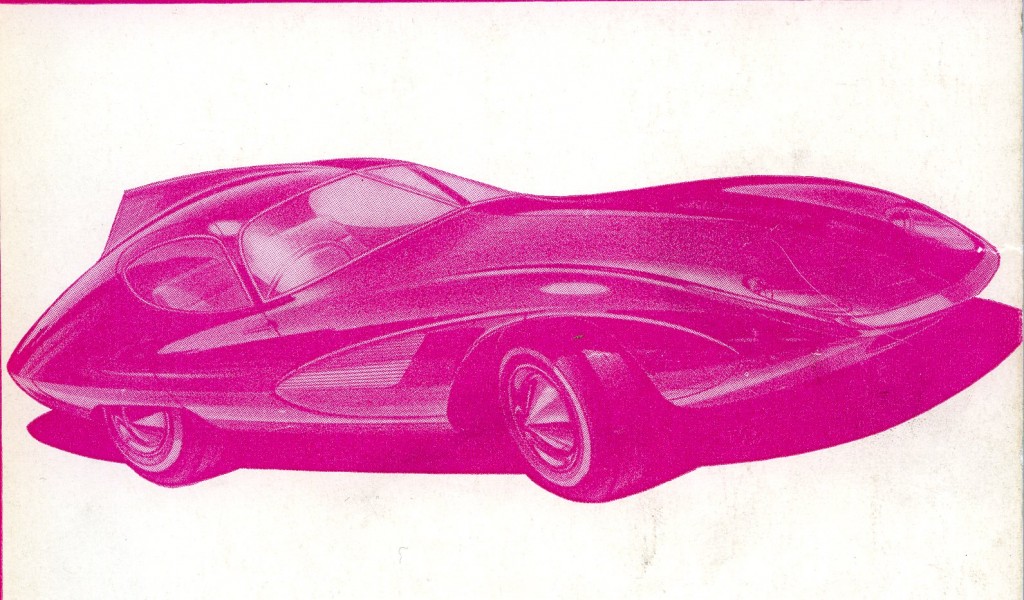
——————————————————————-
Click on the Images Below to View Larger Pictures
——————————————————————-
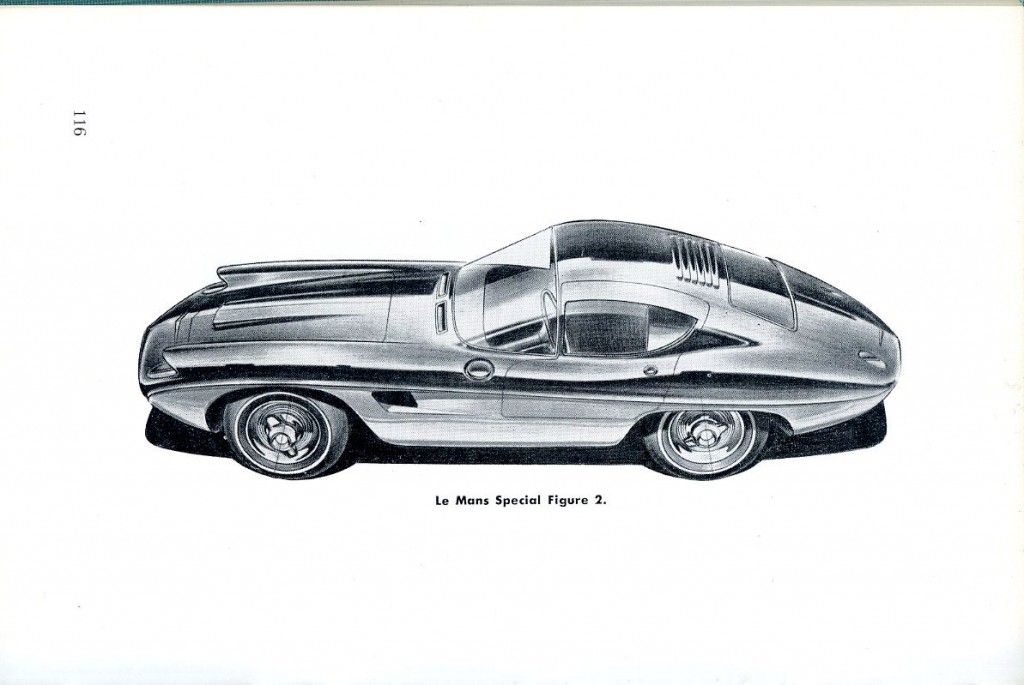
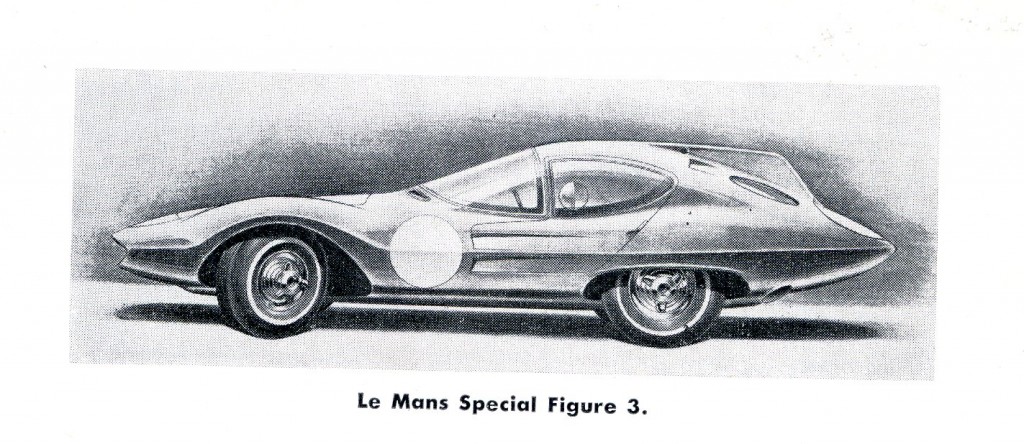
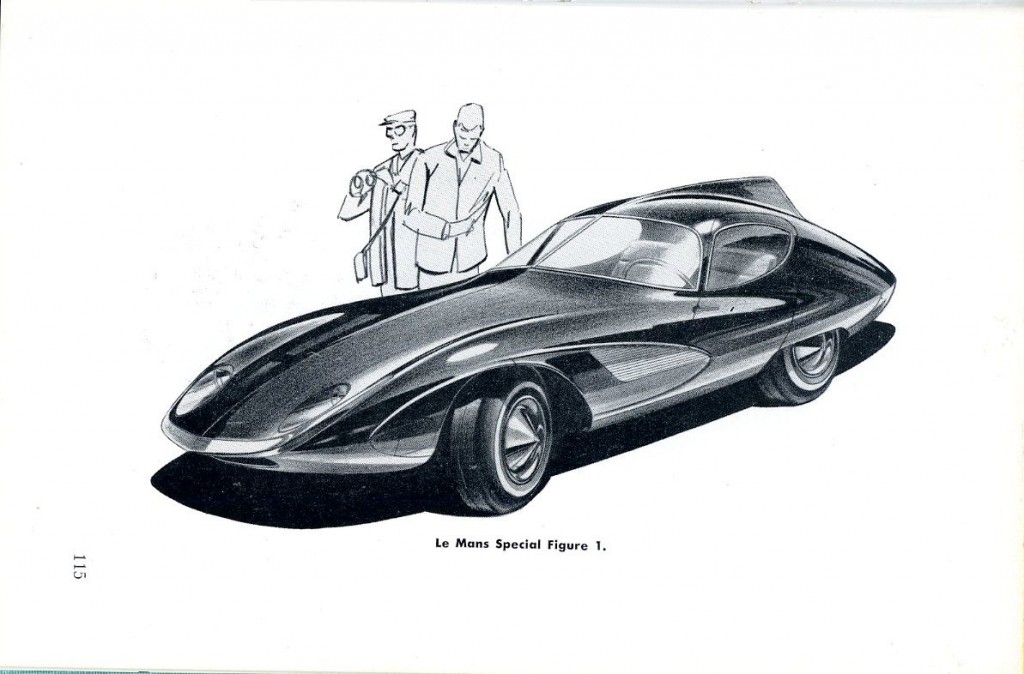
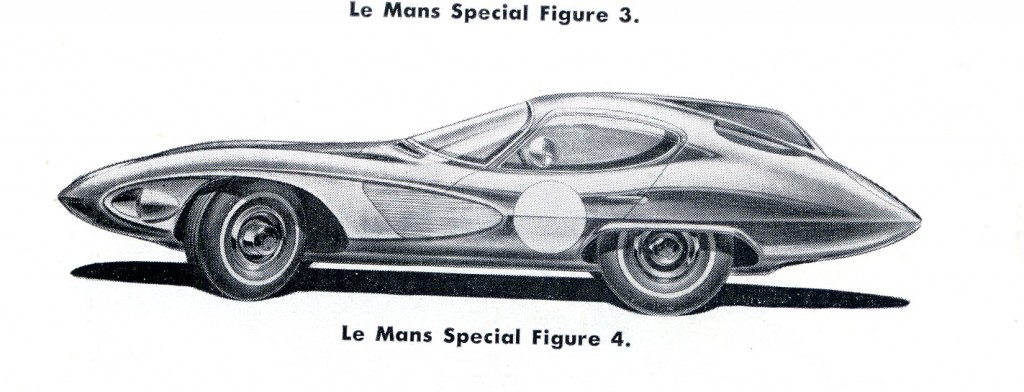
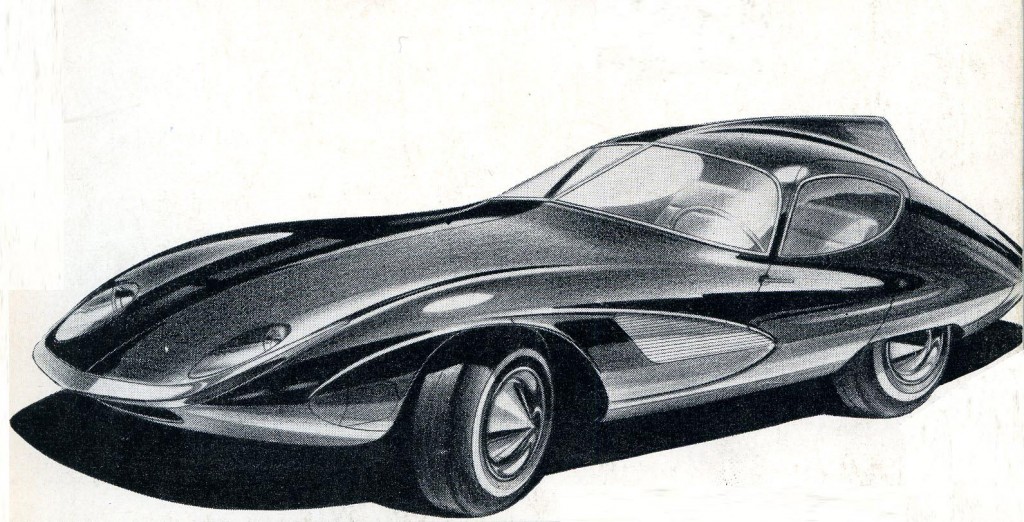
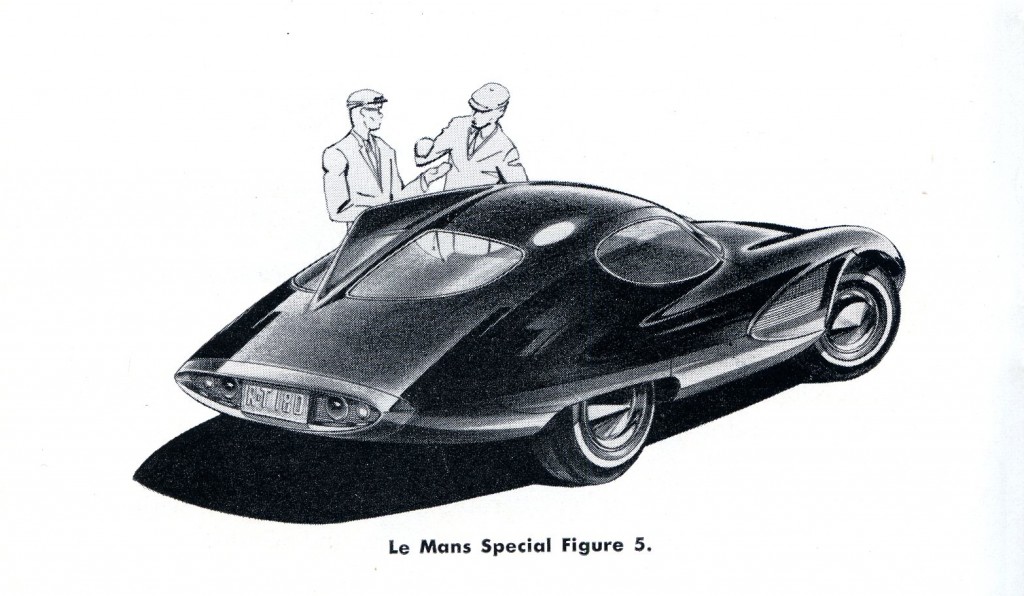









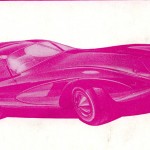
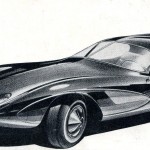
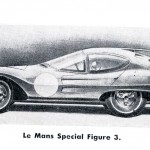
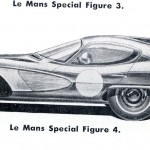
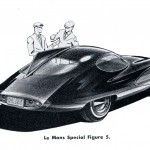

Pingback: Strother MacMinn’s vision for winning Le Mans to com
Pingback: Interesting Aerodynamic Cars (Mike Vetter's ETV, also Avion) - Page 235 - Fuel Economy, Hypermiling, EcoModding News and Forum - EcoModder.com
The book is amazing to say the least… and the designs are breathtaking…
Of all the teachers I had, from grade school through post-grad, Mac stands at the top of the list.
Merrill Powell
Mac’s designs were great.Mac was my Transportation instructor from 1954 to 1957.I used to see him around at auto shows and other events years later and he always remembered me..
Mel
I’m not sure where Mac’s bipo came from. He lived most of his life in Pasadena, home of Cal Tech and the Silver Lake district of L.A. Frank Hershey was a stylist at Walter Murphy in Pasadena. Mac rode his bike to Murphy’s drawing room where he learned to draw cars. Frank then went to GM where he was best known for creating the Silver Streak styling for the Pontiacs. Frank Spring was also a Murphy when Mac was a kid. Spring went on to head the styling studio at Hudson in Detroit. He was chief stylist until American Motors was formed in 1954.
Mac spoke if entering the Navy in 1942. At that point he sold his Cord Sportsman at his father’s request. He could have changed branches during WWII.
The Talbo Lago that Mac liked was most likely Tommy Lee’s, another LA area kid. Also part of the Harley Earl and Frank Kurtis connection to automotive styling history.